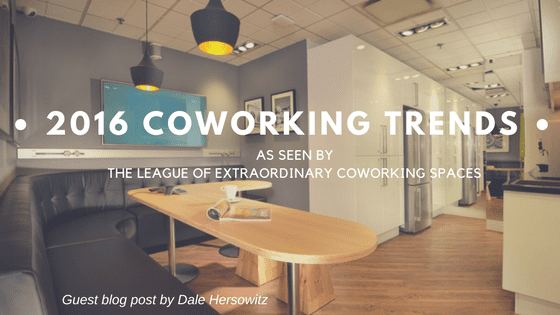Guest post by Dale Hersowitz
It’s an exciting time to be in the Coworking industry. A Forbes article recently stated the Coworking industry has become “one of the largest startup segments, hiding in plain sight” and compared Coworking to popular startup booms like Fintech, virtual reality and drones.
It’s hard to believe that this industry, which started a little over eleven years ago, has already amassed over 11,000 Coworking spaces internationally and is expected to grow to over 26,000 international locations by 2020, with over 3.8 million Coworking members. This growth is due to the way individuals, especially millennials, work and view traditional office space. These changes are unearthing interesting trends in the industry.
The League of Extraordinary Coworking Spaces (LExC, for short) is the first Coworking network organization, comprised of over 70 Coworking locations across the world, where industry leaders share best practices and collaborate at the forefront of innovation and member experience in Coworking. We took a moment to ask a few of our fellow LExC members about trends they are noticing in the Coworking as we are growing together.
The definition of Coworking has evolved
“As the phrase became mainstream, anyone with a shared space adopted it,” said Jamie Russo, Executive Director of GWA and LExC member. “The term used to refer to a shared space with a strong focus on open-plan seating, as well as on culture and community.”
While culture and community are still core values to the Coworking community, the design of the physical space has evolved greatly. WeWork, for example, is using the terminology “Coworking” when describing its business model, but has a layout that is 85-90 percent private offices and meeting rooms.
“The more designed-evolved spaces are focusing on activity-based work settings and providing a wide variety of work settings for the member to choose from depending on their needs at any given moment,” continued Russo.
Existing locations focused on scaling up
“When you look at the Coworking industry, aside from WeWork and a few big players, not a lot of companies have multiple locations—but that is changing,” said Jerome Chang, LExC member and Owner and Architect of BLANKSPACES, a modern Coworking community.
Chang highlights that there is an industry desire to grow and expand Coworking footprint in neighboring communities.
“Most LExC members are already multi-location and the idea of ‘scaling up’ is a common theme in our organization,” continued Chang. “We share best practices on how to grow a Coworking space to the capacity where you are able to add a new location, and how to efficiently, and strategically, open new offices.”
Corporate companies exploring Coworking
With the tremendous opportunity in Coworking, it’s no surprise that corporate companies are getting in on the action.
“LExC members understand that, at some level, even corporate companies need Coworking options,” said Chang.
Two LExC members recently have partnered with corporate companies to explore a new trend in corporate Coworking offerings. Grind Spaces has partnered with Verizon and Workbar has partnered with Staples to take Coworking to a new level.
Workbar recently announced their collaboration with Staples and the first three Workbar @ Staples locations will be opening in suburbs of Boston. Partnering with Staples gives Workbar the ability to offer their members convenient locations with great parking and extended hours, and it allows Staples to enter the growing Coworking industry with a great partner, Workbar.
The industry has evolved past “winging it”
As the Coworking trend grows, areas of specialization are popping up all over the industry. Much like WUN Systems has created a niche technology solution for Coworking spaces, other companies are stepping forward to corner the market on Coworking design.
“Early spaces used a lot of intuition and personal bias for layouts, design and amenities,” said Russo. “Space creators can now draw from industry best practices and work with real estate experts that have Coworking-focused practice groups, such as Colliers and Swearingen. The ability to work with architects and designers that have a portfolio of experience designing shared, collaborative and creative workspaces is a new luxury in the Coworking space.”
Competition among Coworking spaces increasing
The growing Coworking industry is supported by the growing need and appreciation for Coworking spaces. Large cities now have several Coworking options for consumers to choose from, and members are afforded more selectivity when choosing a space.
“There’s more (demand) opportunity and more competition than ever before, driving operators to be strategic about their differentiators,” said Russo. “There is no ‘if you build it, they will come’ approach to designing and managing a Coworking space. Instead, if you build it the consumer will tour and trial every space within a few miles and make a really informed decision about what culture and offerings are the best fit for their unique needs.”
This puts added pressure on operators to understand their market and make sure they are executing the correct member experience, while offering the best technology for a seamless operation and marketing to the right audiences.
Coworking is continuing to grow, and WUN Systems is increasing our participation in industry conversations. Please be sure to visit our blog at www.wunsystems.com for more industry commentary and, to look for a LExC location in a city near you, please visit http://lexc.co/.




